Inductor for fluorescent lamps: device, purpose + circuit for connecting
Agree: the extra devices without which the lighting system may well work, there’s no need to buy and install. Such devices of doubt include the choke for fluorescent lamps. You do not know whether it is needed in the connection diagram or can you do without it?
We will help you deal with the issue. The article details the features, the purpose of the throttle and the functions it performs. The photo and wiring diagram are presented, which will help to independently assemble the fluorescent lamp and start it by correctly connecting all the components to the electrical circuit.
To help the home master, we selected a series of videos containing recommendations on connecting fluorescent bulbs, as well as choosing the right choke, depending on the type of lamp.
The content of the article:
Purpose and throttle device
Discharge lamps, the representative of which is a luminescent variety, cannot be ignited as usual, providing electricity. They simply will not work. To get a glow of this type of source, you will need to additionally use a ballasts.
The purpose of the ballast in the circuit
It turns out that for the functioning of a fluorescent lamp, it is necessary not only to ensure the flow of current, but also to apply voltage to it.
Therefore, the inclusion circuit uses ballast - resistance. It is connected in series with the lamp and is intended to limit the current flowing through its electrodes.
Its role can be performed by various electrical components:
- in the case of direct current, these are resistors;
- with a variable, a choke, a capacitor and a resistor.
Among these devices, the throttle is the most successful option. It has reactance without generating excessive heat. It is able to limit the current, preventing its avalanche-like growth when turned on in the mains.
The throttle is not only an integral element in the starter switching circuit, it performs the following functions:
- contributes to the creation of a safe and sufficient current for a particular light bulb, which ensures the rapid heating of its electrodes during ignition;
- an increased voltage pulse generated in the winding contributes to a discharge in the luminescent bulb;
- provides stabilization of the discharge at the nominal value of electric current;
- contributes to the trouble-free operation of the bulb in spite of voltage fluctuations that periodically occur in the network.
Essential for functioning fluorescent light sources has a choke inductance. Therefore, when buying this electromechanical component, you should pay attention to the technical parameters that must correspond to the characteristics of the bulb.
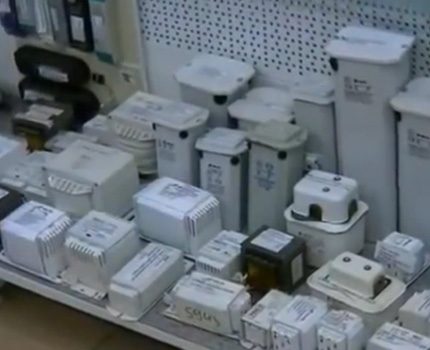
What does the ballast consist of?
The inductor used in the switching circuits of fluorescent type bulbs is nothing but the winding of a wire on the core - an inductor. It is its industrial design that bears the name of the throttle in electrical engineering, which literally translates as "limiter".
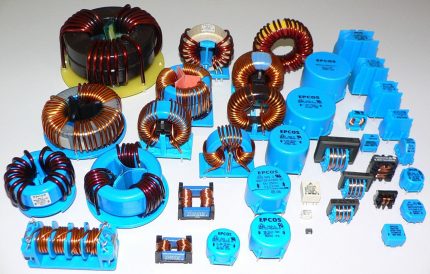
A choke with the necessary technical characteristics is produced in an industrial environment, so the consumer will not have problems when choosing the right option that matches the parameters of the connected light bulb.
Moreover, having the skills to collect various electrical devices, the corresponding components and power tools, you can try to independently build a coil with the desired inductance.
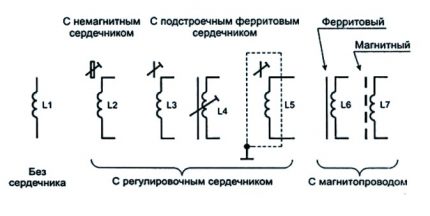
The throttle consists of the following elements:
- wire in insulating material;
- core - most often ferrite type or from other material;
- casting mass, compound - it contains substances resistant to combustion, which provides additional insulation of the turns of the winding wire;
- bodyin which the winding is placed - it is made from heat-resistant polymers.
The presence of the latter element depends on the features and characteristics of a particular current limiter model.
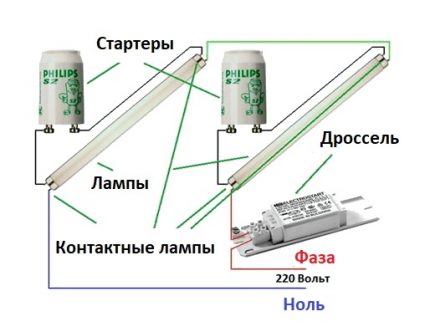
The starter circuit is imperfect, although it shows an excellent result. But the flickering of the bulb, the noise of the throttle and its large size, as well as a false start due to unreliable starter led to the invention of a more advanced version of the ballast control - electronic.
Electronic ballasts in the process of functioning contribute to a reduction in power losses of up to 50%, save from flashing lights. Their use allowed to reduce the mass of chokes, as well as significantly increase the return of the lighting device.
True, the cost of electronic ballast is significantly higher than EMPR, and you need to purchase it from manufacturers with an excellent reputation - such as Philips, Osram, Tridonic, and others.
Scheme + self-connect
You just can’t turn on the fluorescent light - it needs an ignitor and a current limiter. In miniature models, the manufacturer prudently built all these elements into the housing and the consumer can only screw the product into a suitable lamp / chandelier holder and click the switch.
And for larger products, you will need ballasts, which happens both electromechanical and electronic type. In order to connect it correctly, ensuring trouble-free operation of the device, you have to know the procedure for connecting individual elements to the electrical circuit.
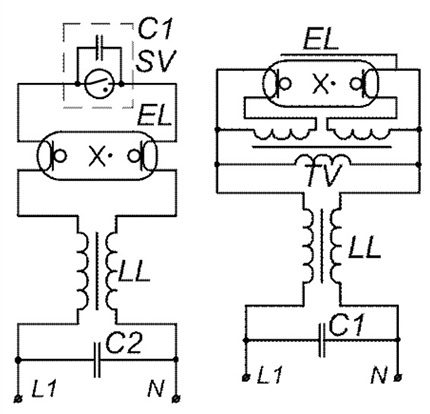
True, having a scheme, but not having practical experience in performing this kind of work, it will be difficult to cope with the task. Moreover, if the connection is required to be performed outside the home - in the corridor of an educational institution or other public institution - then unauthorized interference in the operation of the electricity network can turn into problems.
To do this, the staff of the institutions must have an electrician working on an ongoing basis or serving the institution as the need arises for its services.
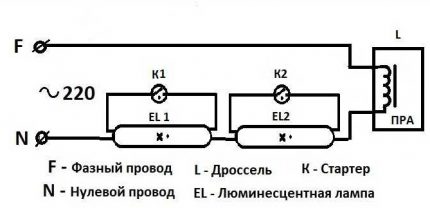
Consider the step-by-step connection of two tubular LL to the mains using the starter circuit. Why do you need 2 starters, a throttling component, the type of which must necessarily correspond to the type of bulbs.
And also you should pay attention to the total power of the starters, which should not exceed this parameter for the inductor.
When connecting the power cable to the lamp, it is important to remember that the inductor is responsible for limiting the current.
So, the phase core will have to be connected through it, and the neutral wire should be connected to the bulb.
A similar connection scheme is relevant for large lighting fixtures. As for the compact models, they are equipped with a built-in trigger and adjustment mechanism - miniature Electronic ballastsmounted inside the product body.
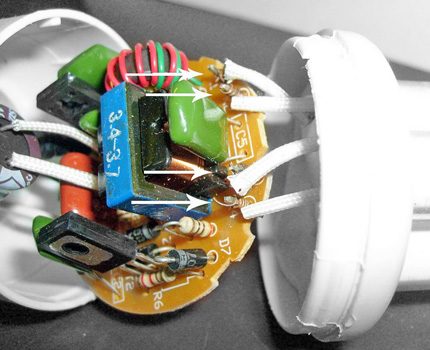
Throttle overheating and possible consequences
The use of light bulbs that have reached the end of their service life and occasionally cause various breakdowns can result in a fire. About how to dispose of used fluorescent devices in detail written here.
To avoid the occurrence of a fire hazard situation will help regular inspection of the condition of lighting devices - visual inspection, verification of the main components.
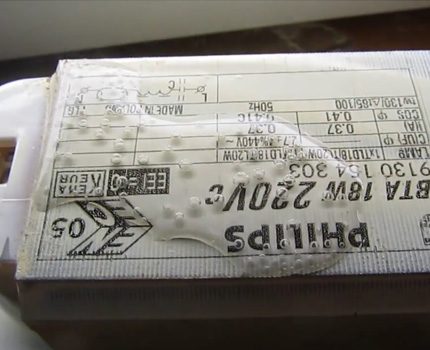
If used improperly, flask explosion may occur. mercury light bulb. The smallest particles are able to scatter within a radius of three meters. Moreover, they retain their incendiary abilities, even falling from the height of the ceiling to the floor.
The danger is overheating of the inductor winding - the apparatus consists of various types of materials, each of which has its own characteristics. For example, manufacturers impregnate insulating gaskets with complex compositions, some elements of which have unequal combustibility and the ability to form smoke.
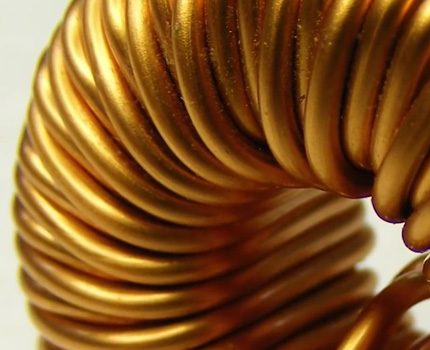
In addition to overheating of the throttling element, there are other situations with fluorescent lamps, representing a fire hazard.
It can be:
- problems caused by a violation of the manufacturing technology of ballasts, which affected the final quality of the apparatus;
- poor material of the diffuser of the lighting device;
- ignition circuit - with or without a starter, the fire hazard is the same.
It should be remembered that carelessness when making a connection, poor quality of contacts or circuit components, which most often occurs when using very cheap devices purchased from unknown manufacturers, can lead to problems.
Conscientious companies give a guarantee on their products, and the technical parameters of the devices indicated on the case or packaging are true. This fact directly affects the service life of both the ballast itself and gas discharge bulbs, with the features of the device and the work of which will familiarize us with the article recommended by us.
Conclusions and useful video on the topic
The subtleties of assembling a circuit of two LL with sequential inclusion:
Video about what a throttle is and why it is needed:
Checking the throttle for damage:
About the rules for choosing a throttle depending on the type of discharge lamp:
Having familiarized yourself with the purpose and arrangement of the chokes used to start the fluorescent bulbs, you can arm yourself with a connection circuit and try to implement it yourself. True, this is true for the home..
In public institutions, the solution of such issues should be entrusted to electricians with special access to electrical work.
Please write comments in the block below, post a photo on the topic of the article, ask questions. Tell us about how you selected and connected the throttle. Share useful information on aspects of device selection and installation technology.

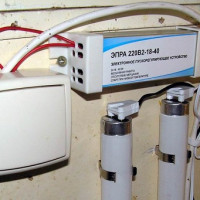 Electronic ballasts for fluorescent lamps: what it is, how it works, wiring diagrams for lamps with electronic ballasts
Electronic ballasts for fluorescent lamps: what it is, how it works, wiring diagrams for lamps with electronic ballasts 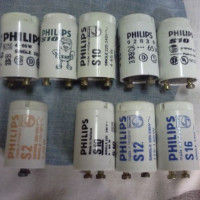 Starter for fluorescent lamps: device, principle of operation, marking + subtleties of choice
Starter for fluorescent lamps: device, principle of operation, marking + subtleties of choice 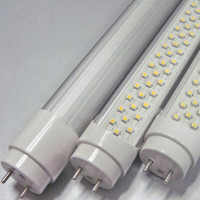 Replacing fluorescent lamps with LEDs: the reasons for the replacement, which are better, replacement instructions
Replacing fluorescent lamps with LEDs: the reasons for the replacement, which are better, replacement instructions  Ballast for fluorescent lamps: why is it needed, how it works, types + how to choose
Ballast for fluorescent lamps: why is it needed, how it works, types + how to choose 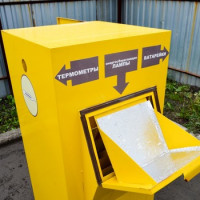 Disposal of fluorescent lamps: where should you dispose of spent appliances
Disposal of fluorescent lamps: where should you dispose of spent appliances 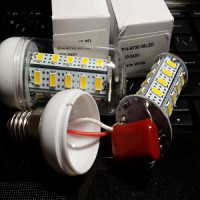 How to choose a LED lamp driver: types, purpose + connection features
How to choose a LED lamp driver: types, purpose + connection features  How much does it cost to connect gas to a private house: the price of organizing gas supply
How much does it cost to connect gas to a private house: the price of organizing gas supply  The best washing machines with dryer: model rating and customer tips
The best washing machines with dryer: model rating and customer tips  What is the color temperature of light and the nuances of choosing the temperature of the lamps to suit your needs
What is the color temperature of light and the nuances of choosing the temperature of the lamps to suit your needs  Replacement of a geyser in an apartment: replacement paperwork + basic norms and requirements
Replacement of a geyser in an apartment: replacement paperwork + basic norms and requirements
During the work as an electrician, these fixtures outweighed an unlimited amount. The choke is the heaviest element in a fluorescent lamp. Usually, before installing the lamp, the throttle is checked with a multimeter or simply “control” (this is an LED connected to a finger battery). If there is no break, then the LED lights up, which means that the throttle is working.
Good afternoon, Victor. You can, of course, use the control LED, but the control with an incandescent lamp will be more informative. Let me explain: if during the test the lamp does not light, then there is a break in the ballast; if burns brightly - interturn short; if the brightness is half the glow, then the throttle is working. Screenshot of the circuit attached.
Of course, the surest way to find the place of damage is to use a multimeter.